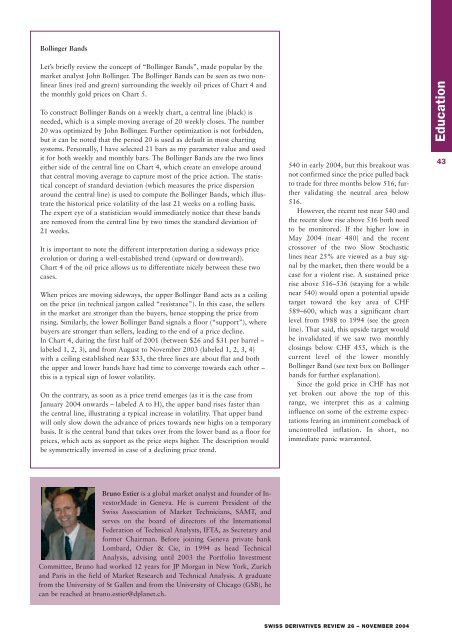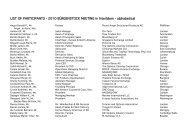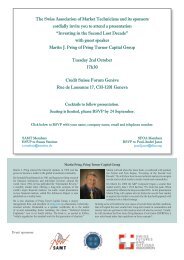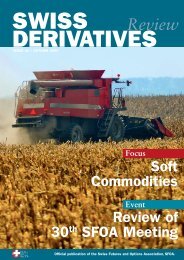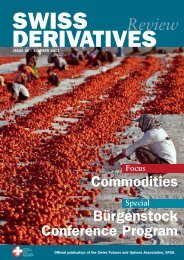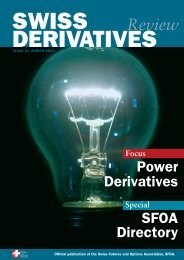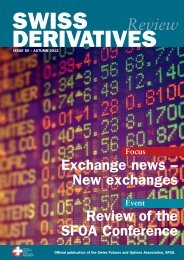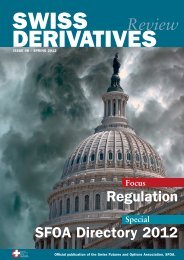Download PDF, Issue 26 - Swiss Futures and Options Association
Download PDF, Issue 26 - Swiss Futures and Options Association
Download PDF, Issue 26 - Swiss Futures and Options Association
Create successful ePaper yourself
Turn your PDF publications into a flip-book with our unique Google optimized e-Paper software.
Bollinger B<strong>and</strong>s<br />
Let’s briefly review the concept of “Bollinger B<strong>and</strong>s”, made popular by the<br />
market analyst John Bollinger. The Bollinger B<strong>and</strong>s can be seen as two nonlinear<br />
lines (red <strong>and</strong> green) surrounding the weekly oil prices of Chart 4 <strong>and</strong><br />
the monthly gold prices on Chart 5.<br />
To construct Bollinger B<strong>and</strong>s on a weekly chart, a central line (black) is<br />
needed, which is a simple moving average of 20 weekly closes. The number<br />
20 was optimized by John Bollinger. Further optimization is not forbidden,<br />
but it can be noted that the period 20 is used as default in most charting<br />
systems. Personally, I have selected 21 bars as my parameter value <strong>and</strong> used<br />
it for both weekly <strong>and</strong> monthly bars. The Bollinger B<strong>and</strong>s are the two lines<br />
either side of the central line on Chart 4, which create an envelope around<br />
that central moving average to capture most of the price action. The statistical<br />
concept of st<strong>and</strong>ard deviation (which measures the price dispersion<br />
around the central line) is used to compute the Bollinger B<strong>and</strong>s, which illustrate<br />
the historical price volatility of the last 21 weeks on a rolling basis.<br />
The expert eye of a statistician would immediately notice that these b<strong>and</strong>s<br />
are removed from the central line by two times the st<strong>and</strong>ard deviation of<br />
21 weeks.<br />
It is important to note the different interpretation during a sideways price<br />
evolution or during a well-established trend (upward or downward).<br />
Chart 4 of the oil price allows us to differentiate nicely between these two<br />
cases.<br />
When prices are moving sideways, the upper Bollinger B<strong>and</strong> acts as a ceiling<br />
on the price (in technical jargon called “resistance”). In this case, the sellers<br />
in the market are stronger than the buyers, hence stopping the price from<br />
rising. Similarly, the lower Bollinger B<strong>and</strong> signals a floor (“support”), where<br />
buyers are stronger than sellers, leading to the end of a price decline.<br />
In Chart 4, during the first half of 2001 (between $<strong>26</strong> <strong>and</strong> $31 per barrel –<br />
labeled 1, 2, 3), <strong>and</strong> from August to November 2003 (labeled 1, 2, 3, 4)<br />
with a ceiling established near $33, the three lines are about flat <strong>and</strong> both<br />
the upper <strong>and</strong> lower b<strong>and</strong>s have had time to converge towards each other –<br />
this is a typical sign of lower volatility.<br />
On the contrary, as soon as a price trend emerges (as it is the case from<br />
January 2004 onwards – labeled A to H), the upper b<strong>and</strong> rises faster than<br />
the central line, illustrating a typical increase in volatility. That upper b<strong>and</strong><br />
will only slow down the advance of prices towards new highs on a temporary<br />
basis. It is the central b<strong>and</strong> that takes over from the lower b<strong>and</strong> as a floor for<br />
prices, which acts as support as the price steps higher. The description would<br />
be symmetrically inverted in case of a declining price trend.<br />
540 in early 2004, but this breakout was<br />
not confirmed since the price pulled back<br />
to trade for three months below 516, further<br />
validating the neutral area below<br />
516.<br />
However, the recent test near 540 <strong>and</strong><br />
the recent slow rise above 516 both need<br />
to be monitored. If the higher low in<br />
May 2004 (near 480) <strong>and</strong> the recent<br />
crossover of the two Slow Stochastic<br />
lines near 25% are viewed as a buy signal<br />
by the market, then there would be a<br />
case for a violent rise. A sustained price<br />
rise above 516–536 (staying for a while<br />
near 540) would open a potential upside<br />
target toward the key area of CHF<br />
589–600, which was a significant chart<br />
level from 1988 to 1994 (see the green<br />
line). That said, this upside target would<br />
be invalidated if we saw two monthly<br />
closings below CHF 455, which is the<br />
current level of the lower monthly<br />
Bollinger B<strong>and</strong> (see text box on Bollinger<br />
b<strong>and</strong>s for further explanation).<br />
Since the gold price in CHF has not<br />
yet broken out above the top of this<br />
range, we interpret this as a calming<br />
influence on some of the extreme expectations<br />
fearing an imminent comeback of<br />
uncontrolled inflation. In short, no<br />
immediate panic warranted.<br />
Education<br />
43<br />
Bruno Estier is a global market analyst <strong>and</strong> founder of InvestorMade<br />
in Geneva. He is current President of the<br />
<strong>Swiss</strong> <strong>Association</strong> of Market Technicians, SAMT, <strong>and</strong><br />
serves on the board of directors of the International<br />
Federation of Technical Analysts, IFTA, as Secretary <strong>and</strong><br />
former Chairman. Before joining Geneva private bank<br />
Lombard, Odier & Cie, in 1994 as head Technical<br />
Analysis, advising until 2003 the Portfolio Investment<br />
Committee, Bruno had worked 12 years for JP Morgan in New York, Zurich<br />
<strong>and</strong> Paris in the field of Market Research <strong>and</strong> Technical Analysis. A graduate<br />
from the University of St Gallen <strong>and</strong> from the University of Chicago (GSB), he<br />
can be reached at bruno.estier@dplanet.ch.<br />
SWISS DERIVATIVES REVIEW <strong>26</strong> – NOVEMBER 2004


